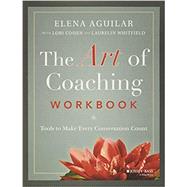A practical guide for getting the most out of The Art of Coaching
The Art of Coaching Workbook is the resource you’ve been waiting for to accompany Elena Aguilar’s The Art of Coaching. Ideal for new and novice coaches, as well as for those who have years of coaching under their belt, this workbook will help you improve your coaching skills.
This vital companion text includes:
- Dozens of activities to help you internalize the concepts described in The Art of Coaching
- Exercises to guide you in identifying your own coaching beliefs, style, and practices
- Short and lengthy transcripts of coaching conversations
- Additional examples of key concepts in The Art of Coaching, including the Ladder of Inference and the Coaching Lenses
- New ideas and information that build on those in The Art of Coaching
This workbook is also for those who lead and manage coaches. An entire chapter is dedicated to structures, routines, and practices that are easy to implement in professional development sessions. In addition, a new Transformational Coaching Rubric and other tools for assessment and reflection are included. If you aspire to provide meaningful learning for coaches, and you already have The Art of Coaching, this workbook is all you’ll need.








